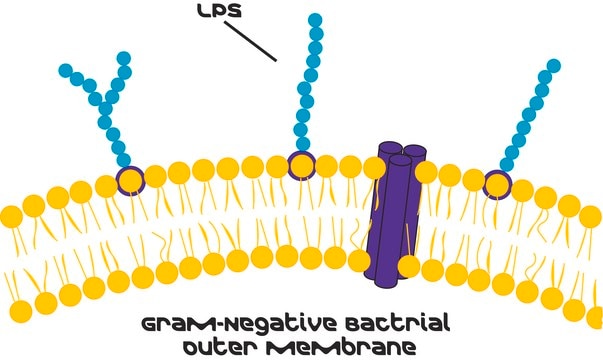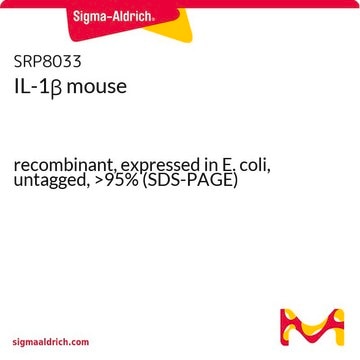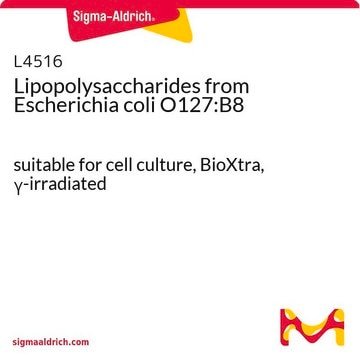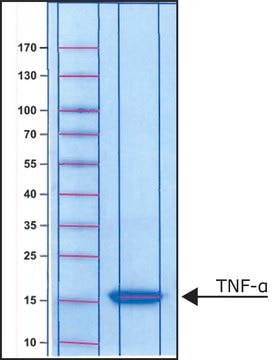SRP4896
TSLP human
recombinant, expressed in E. coli, ≥97% (SDS-PAGE), ≥97% (HPLC)
Synonym(s):
Thymic Stromal Lymphopoietin
Sign Into View Organizational & Contract Pricing
All Photos(1)
About This Item
UNSPSC Code:
51111800
NACRES:
NA.32
Recommended Products
biological source
human
recombinant
expressed in E. coli
assay
≥97% (HPLC)
≥97% (SDS-PAGE)
form
lyophilized
potency
<0.3 ng/mL ED50
mol wt
~15.0 kDa
packaging
pkg of 20 μg
storage condition
avoid repeated freeze/thaw cycles
impurities
endotoxin, tested
NCBI accession no.
shipped in
wet ice
storage temp.
−20°C
Gene Information
human ... TSLP(85480)
General description
Thymic stromal lymphopoietin (TSLP) is a hemopoietic cytokine. It is part of the interleukin-2 (IL-2) cytokine family. It is mainly expressed in the heart, liver and prostate. TSLP is related in its biological activities to interleukin-7 (IL-7) and binds with the heterodimeric receptor complex consisting of interleukin-7 receptor α chain & the TSLP receptor. Recombinant human TSLP produced in Escherichia coli is a single, non-glycosylated polypeptide chain containing 132 amino acids and having a molecular mass of 15kDa.
Application
TSLP human has been used in immunohistochemistry.
Biochem/physiol Actions
Thymic stromal lymphopoietin (TSLP) signals throughout a heterodimeric receptor complex composed of the thymic stromal lymphopoietin receptor and the interleukin-7 (IL-7) receptor a chain. TSLP impacts myeloid cells and thus induces the discharge of T cell-attracting chemokines from monocytes and increases the growth of CD11c+ dendritic cells. Similar to IL-7, TSLP enhances phosphorylation of signal transducer and activator of transcription 3 and 5 (STAT3 and STAT5), though uses kinases excluding Janus kinases (JAKs) for its activation. TSLP induces the release of T cell-attracting chemokines such as thymus and activation-regulated chemokine (TARC) and macrophage-derived chemokine (MDC) from monocytes and triggers CD11c+ dendritic cells. TSLP activated dendritic cells primes naive T cells to manufacture pro-allergic cytokines such as interleukin-4, interleukin-5, interleukin-13 and tumor necrosis factor-α (TNF-α), whereas down-regulating interleukin-10 and interferon-γ (IFN-γ) play a role in the initiation of allergic inflammation.
Physical form
Lyophilized from a concentrated solution (1 mg/ml) containing 130 mM NaCl, and 20 mM sodium phosphate, pH 7.4.
Reconstitution
Centrifuge the vial prior to opening. Avoid freeze-thaw cycles.
Reconstitute in sterile dH2O to a concentration of 0.1 -1 mg/mL and let the lyophilized pellet dissolve completely. This solution can then be diluted into other aqueous buffers.
wgk_germany
WGK 3
flash_point_f
Not applicable
flash_point_c
Not applicable
Certificates of Analysis (COA)
Search for Certificates of Analysis (COA) by entering the products Lot/Batch Number. Lot and Batch Numbers can be found on a product’s label following the words ‘Lot’ or ‘Batch’.
Already Own This Product?
Find documentation for the products that you have recently purchased in the Document Library.
Thymic stromal lymphopoietin expression is increased in asthmatic airways and correlates with expression of Th2-attracting chemokines and disease severity.
Ying S
Journal of Immunology, 174(12), 8183-8190 (2005)
Unusual Timing of CD127 Expression by Mouse Uterine Natural Killer Cells
Jianhong Zhang
Journal of Leukocyte Biology, 91(3), 417-426 (2012)
The biology of thymic stromal lymphopoietin (TSLP).
Ziegler SF
Advances in Pharmacology, 66, 129-155 (2013)
Frederique M Moret et al.
Arthritis & rheumatology (Hoboken, N.J.), 66(5), 1176-1184 (2014-05-02)
To determine the levels of thymic stromal lymphopoietin (TSLP) and the numbers of TSLP receptor (TSLPR)-expressing CD1c+ (blood dendritic cell antigen 1-positive) myeloid dendritic cells (MDCs) in the joints as compared with the peripheral blood (PB) of patients with rheumatoid
Chun I Yu et al.
Journal of immunology (Baltimore, Md. : 1950), 193(9), 4335-4343 (2014-09-24)
Dendritic cells (DCs) play the central role in the priming of naive T cells and the differentiation of unique effector T cells. In this study, using lung tissues and blood from both humans and humanized mice, we analyzed the response
Our team of scientists has experience in all areas of research including Life Science, Material Science, Chemical Synthesis, Chromatography, Analytical and many others.
Contact Technical Service




